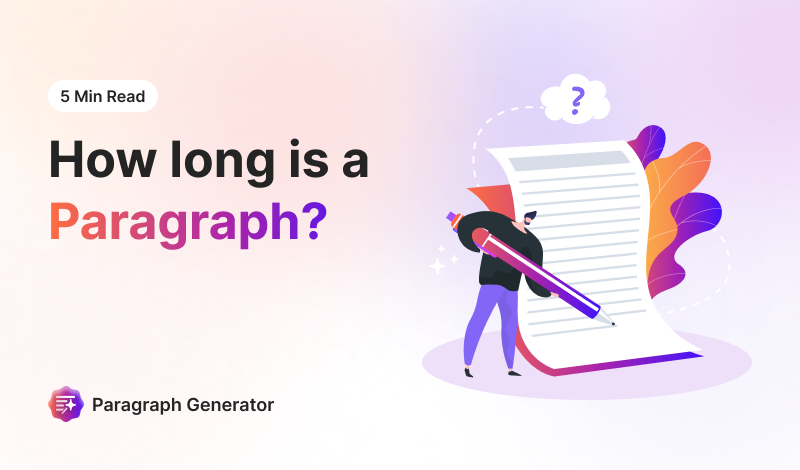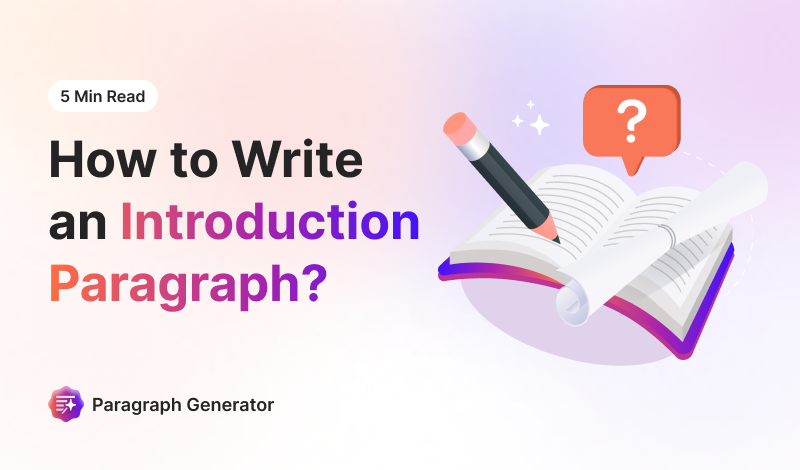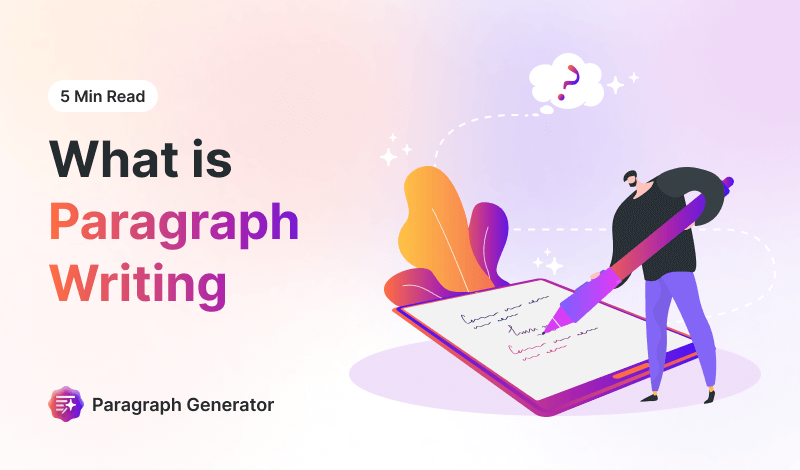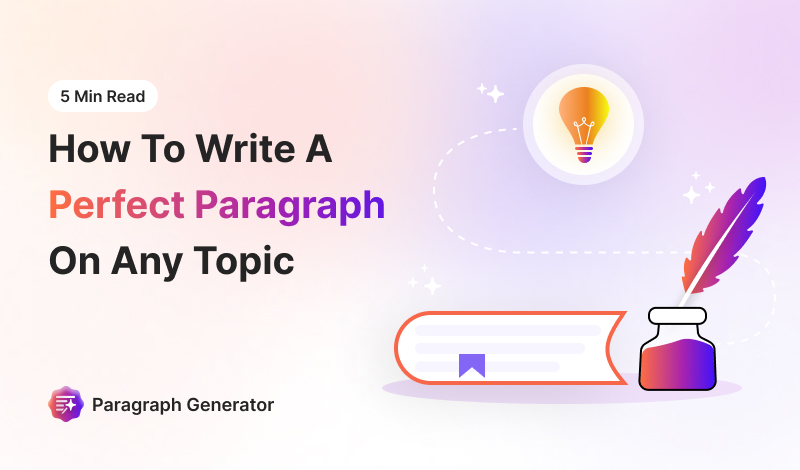Traditionally, a paragraph is seen as a unit of writing that describes a single idea, containing at least three to five sentences.
However, in an educational context, paragraph length varies by grade level. Similarly, the length of a paragraph also depends on various factors, such as writing style, audience, and the medium in which we write.
In this article, we will look at how long a paragraph can be under 2 different contexts.
Paragraph length for different educational levels.
The length of Paragraphs depending on writing style, audience, and medium.
Paragraph Length for Different Educational Levels
The length of the paragraphs slowly extends after each class and school level. Let’s learn what is the recommended number of words and sentences for each grade.
Early Elementary (kg - 3):
At this stage, paragraphs are typically 1-3 sentences (nearly 5 to 40 words) long. These short paragraphs can define a single term, describe a simple action, or express a straightforward idea.
Let’s list the approximate number of sentences for each grade in the early elementary level.
Kindergarten:
At the KG level, students learn to recognize letters and words. So the paragraphs are kept small and simple.
They contain 1 to 2 sentences and 5 to 15 words (approx).
(A kindergarten-level worksheet for paragraphs by k5learning)
Examples:
“The cat is big. It purrs”
“See the sun. It is yellow.”
(More examples in the children's book “Go. Dog, Go!” by p.d Eastman)
1st Grade:
First graders are familiar with letters but cannot read words easily. Therefore, paragraphs are still shorter but contain a bit larger sentences.
Paragraphs usually consist of 1 to 3 sentences and 10 to 20 words.
(read more about 1st and 2nd grade paragraph writing on brownbagteacher)
Examples:
“Little bird flies high. Up in the blue sky.”
"The dog runs fast. It has a red ball."
(Watch the World Book Day’s video adaptation of Dear Zoo Flipbook.)
2nd and 3rd Grade:
In second and third grade, students are efficient at word-reading. Hence, they can easily read larger sentences. But still, it can be difficult for them to understand more than 3 sentences in one paragraph.
At this stage, a paragraph can be made up of 2 to 3 sentences that contain 20 to 40 words.
(A reading worksheet by superteacherworksheet for third grade.)
Examples:
"Max has a pet frog named Hopper. He feeds Hopper flies and keeps him in a big tank. Hopper likes to jump very high."
"Sarah loves to read books about space. She dreams of being an astronaut and traveling to the moon. Her favorite book is about the solar system."
To read more examples for 2nd and 3rd grade-level paragraphs, see
"The Very Hungry Caterpillar" by Eric Carl
"I Want My Hat Back" by Jon Klassen
Elementary (4th and 5th):
In 4th and 5th grade, learners become fluent in sentence reading. Therefore, a paragraph at this level can contain up to 5 sentences i.e. almost 30 to 80 words. Also, the sentences are larger and a little more complex than before.
4th Grade:
Students at this stage can now read to learn instead of learn to read. This is why paragraphs are informative. This enables them to write a well-constructed paragraph that contains a topic sentence followed by supporting and concluding sentences.
It is recommended that they write 2 to 4 sentences per paragraph typically ranging from 30 to 65 words.
(Writing expectations pdf by resources.finalsite.net for 4th grade)
Examples:
"Every fall, the leaves on the maple trees undergo a stunning transformation. The leaves turn vibrant shades of reds, oranges, and yellows, brightening up the neighborhood. This change is due to the trees preparing for winter by ceasing the production of a green pigment called chlorophyll. As a result, we get to enjoy the beautiful colors that signal the arrival of autumn."
"Dolphins are renowned for their intelligence and friendly nature. They use a variety of clicks and whistles to communicate, which aids them in locating food and navigating the vast ocean. Researchers have devoted years to studying these communications to better understand dolphins' complex social behaviors. These studies reveal the depth of their social interactions and intelligence."
(Time for Kids has a vast amount of news articles for each grade.)
5th Grade:
At the end of primary school i.e. 5th grade, students can clearly understand the central theme of paragraphs. So each paragraph contains at least 3 to 5 sentences. The word count can be nearly 40 to 50 words for shorter paragraphs and 70 to 80 words for larger paragraphs.
Examples:
"Hurricanes are powerful storms that form over warm ocean waters. They can cause massive damage when they hit land due to strong winds and heavy rain. Scientists name each hurricane to track them more easily. Understanding how they form helps us prepare better and protect communities."
“The Amazon rainforest is often called the 'lungs of the Earth' because it produces over 20% of the world's oxygen. This vast forest covers several countries in South America and is home to millions of plant and animal species. Many of these species are unique to the Amazon and cannot be found anywhere else in the world. Unfortunately, this important ecosystem is threatened by deforestation, which affects the biodiversity and climate of the entire planet.”
(National Geographic Kids for informative posts suitable for 5th graders.)
Middle school:
In middle school, students are expected to write and understand more complicated and longer paragraphs compared to elementary school. The paragraph length typically increases as students develop their ability to express more ideas and add evidence. There are 4 to 7 sentences and 60 to 140 words per paragraph on average.
(An mcps pdf guide on writing paragraphs in middle school.)
Here’s a general guideline for middle school paragraph lengths:
6th and 7th Grade
By 6th grade, students start to understand more detailed descriptions and can discuss simple concepts with some depth. They are encouraged to add more details. That is why the paragraphs can stretch up to 4 to 6 sentences. That is roughly 60 to 120 words per paragraph.
Example:
"Late one night, under the blanket of darkness, Emily stumbled upon an old, dusty book in the attic. The cover was worn, and the pages smelled of ancient oak wood. As she opened it, a faint glow began to emanate from the pages, lighting up her curious face. Each word she read took her deeper into tales of enchanted forests and mysterious creatures. With every turn of the page, Emily felt as if she were stepping further into a world where magic knew no bounds."
(The first 3 Harry Potter books by J.K. Rowling are best for more narrative paragraph examples according to middle grade.)
"School cafeterias should start offering more fruit and vegetable options. Currently, many cafeterias serve foods high in calories but low in nutritional value, which can contribute to various health problems among students. By increasing the availability of fruits and vegetables, schools can encourage healthier eating habits that support students' growth, concentration, and overall health. Moreover, introducing a variety of healthy options not only caters to students with different dietary needs but also educates them on making balanced food choices. Therefore, it is crucial for schools to prioritize the well-being of students by improving the cafeteria menu."
(Read this blog post by choiceliteracy on persuasive paragraph writing in middle school)
8th Grade:
By the end of middle school, students become experts in writing paragraphs on most topics. They have also learned to write essays with multiple paragraphs by this time. So at this level, the recommended number of sentences per paragraph is 4 to 7 and 70-140 words.
Examples:
"The Great Wall of China stands as one of the most enduring symbols of Chinese engineering and perseverance. Built over centuries, this massive structure was primarily designed to protect against invasions and raids by nomadic groups of the Eurasian Steppe. The wall stretches over 13,000 miles, making it one of the world's most impressive defensive structures. It also played a crucial role in controlling trade along the Silk Road, influencing the economic and cultural landscape of Asia. Today, the Great Wall is recognized as a UNESCO World Heritage site and continues to be a symbol of national pride and historical significance."
(Khan Academy - articles on various topics for grade 8)
High School
In grades 9th to 12th, students no longer face any problems in paragraph writing. Instead, their focus is more on conveying the information and covering all the details. This demands larger paragraphs.
In high schools, the recommended paragraph length is 5-7 sentences (100-150 words).
(Read about high school paragraph writing from an article by West Seattle High School)
Examples:
"The Renaissance was a pivotal period in human history, marking a time of profound cultural and intellectual growth that began in Italy in the 14th century. This era is characterized by significant advancements in art, literature, and science, and it laid the groundwork for modern Western society. Figures such as Leonardo da Vinci and Michelangelo not only produced iconic artworks but also contributed to scientific observations that defied the prevailing norms of their time. The Renaissance also spurred changes in social and political structures, influencing the development of modern democracy. Understanding this period helps explain how historical shifts in thought and culture shape societal evolution."
(Newsela - Tailor's news and informational articles to multiple reading levels including high school)
College and Beyond
In college and beyond, paragraphs can extend to more than 8 sentences. This is because the students in college prepare to write research papers and professional publications. Hence, a typical paragraph can contain 6 to 8 and sometimes more sentences ( 200 to 300 words approx.).
(Writing academically: paragraph structure by Hull University Library)
Example
"The concept of freedom has evolved significantly throughout history, reflecting the changing cultural, economic, and political landscapes. In ancient societies, freedom was often viewed through the lens of governance and the rights of citizens within city-states. For instance, in classical Athens, freedom was closely tied to one's status as a citizen and participation in the democratic process. In the modern era, however, the notion of freedom has expanded to include not just political rights but also economic and social dimensions. Economists like Amartya Sen argue that true freedom involves not only the availability of choices but also the capability to exercise these choices effectively. This broader understanding of freedom underpins many international human rights campaigns and development strategies today, highlighting the intersection between freedom, equity, and global justice. Such perspectives are critical in discussions of policy-making and governance, suggesting that our conception of freedom must adapt to ensure it encompasses the diverse needs and rights of all global citizens."
(The Chronicles of Higher Education - a good mix of news and scholarly articles for college level.)
The following table provides a clear breakdown of how paragraph lengths change through the educational level.
Educational Level | Paragraph Length | Number of Sentences | Word Count (Approx.) | Age Group |
Early Elementary (KG - 3rd Grade) | Short | 1-3 | 5-40 | 5-9 years |
Elementary (4th and 5th Grade) | Medium | 3-5 | 40-80 | 9-11 years |
Middle School (6th - 8th Grade) | Medium to Long | 4-6 | 60-120 | 11-14 years |
High School (9th - 12th Grade) | Long | 5-7 | 100-150 | 14-18 years |
College and Beyond | Extended | 6-8+ | 150-300+ | 18+ years |
The length of Paragraphs depending on writing style, audience, and medium.
If we set aside the educational point of view, there are some other factors affecting the paragraph length as well. These factors are:
Purpose of the writing
Audience
Medium
Let’s see why and how they change a paragraph’s length.
Purpose of Writing:
The number of sentences or words is highly related to the type of paragraph you write. For instance, a paragraph in narrative writing is usually 3-5 words long. While in descriptive paragraphs, it is common to see 5 to 8 sentences per paragraph.
Narrative writing:
It is a type of writing that tells a story. It involves creating characters, setting a scene, and developing a plot. Paragraphs in narrative writing can have 3 to 5 sentences on average and 60 to 150 words. However, they can be larger depending on the need of the story.
(1. indeed: What is narrative writing? Types and tips.
2. BBC Bitesize: Offers guides and examples for various writing styles, including narrative writing)
Example:
"The sun set in a blaze of orange and pink, painting the horizon in vivid hues. On the beach below, children played tag, their laughter mingling with the rhythmic crash of the waves. Each time the water retreated, it erased their footprints, making every sandy step seem fleeting and precious. Nearby, an old man watched quietly, his loyal dog at his side, both soaking in the fleeting moments of daylight that danced on the shimmering waters."
("Bird by Bird" by Anne Lamott provides guidance on writing and narrative techniques)
Expository Writing:
In this writing style, you explain, inform, or define a topic to the reader. It's often used in textbooks, essays, news articles, and how-to guides. Since the purpose is to provide information, too many sentences are not favored in this writing.
An expository paragraph might define a concept in two to three sentences (30 to 50 words) followed by an explaining paragraph of the same length mentioning its relevance or application.
(A helpful Amazon pdf guide on learning to write an expository paragraph)
Example:
"Genetic engineering refers to the direct manipulation of an organism's genes using biotechnology. It is a set of technologies used to change the genetic makeup of cells, including the transfer of genes within and across species boundaries to produce improved or novel organisms.
An important application of genetic engineering is in agriculture, where it is used to enhance crop resistance to pests and herbicides. This not only helps in increasing crop yields but also reduces the need for chemical pesticides, promoting a more sustainable form of agriculture."
These paragraphs are a single example that shows both conceptual and explanatory paragraphs in expository writing, both containing 2 sentences.
(BBC News - an online newspaper that often uses shorter paragraphs to make the information more easy to understand.)
Persuasive Writing:
Here, paragraph length can vary. A short paragraph usually makes a strong statement. In contrast, a longer paragraph gives details and evidence to support ideas.
For example, an editorial might start with a brief, powerful paragraph that presents an opinion, followed by longer paragraphs that back up that opinion with data and research.
So the shorter paragraph(assertive) can consist of 1 to 2 sentences and 20 to 50 words while larger paragraphs(supporting) can have 3 to 5 sentences or more (60 to 120 words).
(Know the basics of persuasive writing at Wikipedia)
Example:
"Recycling is not just a way to reduce waste and environmental impact; it is a necessity for a sustainable planet.
Each year, millions of tons of plastic are produced, and a significant portion ends up in our oceans, harming marine life and ecosystems. By recycling plastic, paper, and other materials, we reduce the amount of waste that ends up in landfills and oceans, conserve natural resources, and save energy. Therefore, increasing our commitment to recycling programs is essential for environmental conservation and should be a priority for our community."
In this example, the first paragraph is bold and contains only one sentence while the second paragraph has three lines and supports the first paragraph.
(The Conversation: provides persuasive articles with evidence)
- Descriptive Writing:
Descriptive paragraphs can also vary in length. A long paragraph describes a scene or object in detail. In contrast, a shorter paragraph mentions important points only.
However, if a paragraph becomes too long in descriptive writing, it can be difficult to keep the reader engaged. Overly lengthy paragraphs may contain too many ideas or excessive detail. Therefore, it is important to keep balance.
Normally the range for descriptive paragraphs is 4 to 8 sentences and 60 to 200 words.
(Read the article on descriptive writing by reading rocket to learn more)
Example:
"The café was a cozy, dimly lit corner of the world, filled with the rich aroma of freshly brewed coffee and the soft murmur of conversations. Plush velvet sofas invited patrons to sink in, escaping the brisk autumn chill outside. The walls, adorned with abstract art and vintage photographs, told stories of a past era, blending perfectly with the classical music that whispered through the air. Every element of the café was carefully curated to offer a warm embrace to anyone who stepped through its doors."
(See more examples of descriptive paragraphs on thought.co)
Purpose of Writing | Paragraph Type | Sentences | Words |
Narrative Writing | Standard | 3 to 5 | 60-150 |
Expository Writing | Conceptual | 2 to 3 | 30-50 |
Explanatory | 2 to 3 | 30-50 | |
Persuasive Writing | Assertive | 1 to 2 | 20-50 |
Supporting | 3 to 5 | 60-120 | |
Descriptive Writing | Standard | 4 to 8 | 60-200 |
Audience:
As you know for every age group the paragraphs in educational books change and become larger with the next grade. This proves that it is important to consider the target audience while determining the paragraph length.
Young Readers:
Shorter paragraphs with simple sentences keep young readers' attention locked and help them understand new ideas.
This usually includes the age group of 3 to 10 years. The best paragraph length is between 2 to 4 lines and 10 to 50 words.
Example:
"The cat sat on the mat. It was a fluffy cat with a long tail. The mat was red.
The little cat loved its bright red mat. It napped there every day, curled up and cozy."
Another one
"Max found a shiny, smooth rock by the stream. It was round and felt heavy in his hand. He wondered about the adventures the rock had been on. With a smile, he put it in his pocket, ready to take it home."
(Math is fun math website to educate young readers.)
Academic Readers:
Longer, more detailed paragraphs are expected in academic writing, which often includes complex information and citations. It is usually directed towards teens and grown-ups.
A common paragraph contains between 5 to 7 lines (50 to 150 approx.).
Example:
"The concept of climate change encapsulates various global phenomena created predominantly by burning fossil fuels and clearing forests. CO2, a greenhouse gas, traps heat in the atmosphere and regulates our planet’s climate. Historically, the fluctuating concentrations of CO2 have dictated the Earth's temperature variations, leading to repeated ice ages and warm interglacial periods. The current unprecedented rise in CO2 due to human activity is thus a major concern for climatologists."
(Science Direct - an academic platform for scholarly literature.)
Here's a table showing how paragraph lengths vary for different audience types:
Audience | Age Group | Paragraph Length |
Young Readers | 3 to 10 years | 2 to 4 lines, 10 to 50 words |
Academic Readers | Teens to grown-ups | 5 to 7 lines, 50 to 150 words |
Medium and Format
The type of medium where the content is being published also plays a role in paragraph length. Let's show how print and digital media differ in paragraph length.
Print Media:
Longer paragraphs are more common in print, such as in books and academic journals, where detailed exploration of topics is expected. This is because it is easy to read on paper.
Hence, bigger paragraphs are common in print media. They are usually 5 to 7 sentences long.
(Reading linear text on paper versus computer screen - Science Direct)
Example:
"In 'War and Peace,' Tolstoy not only captures the grandeur of his era but also explores the intricacies of everyday life, presenting a broad view of Russian society during the Napoleonic Wars. He uses detailed descriptions and historical analysis to craft a narrative that is rich and multifaceted. The novel delves into philosophical musings and complex relationships, weaving together themes of war, peace, love, and destiny. This complex tapestry challenges readers to reflect on the significant impact of these forces on human existence. Tolstoy’s work encourages a deep contemplation of life’s profound questions, making 'War and Peace' a timeless masterpiece that resonates with readers across generations."
(Amazon’s books section offers a large variety of printed books.)
Digital Media:
Online content tends to favor shorter paragraphs. That is because online users usually have a habit of skipping larger paragraphs. It also strains the eyes to read long paragraphs on screen.
Hence, it is recommended to keep paragraphs concise- between 3 to 5 sentences and 50 to 100 words.
(Digital reading and reading competence - to learn how reading large text blocks online strains the eyes.)
Example:
"Digital marketing is essential for modern businesses. It allows you to reach a broader audience more efficiently and cost-effectively than traditional methods. Strategies like SEO, social media marketing, and email campaigns can dramatically increase your visibility and engagement. Understanding these tools and how to use them effectively is crucial for any competitive business today."
(For online stories and ideas - Medium.com is a great source.)
The table below differentiates between the length of paragraphs on digital and print media.
Medium | Characteristics | Common Length | Word Count |
Print Media | Longer paragraphs, detailed exploration. | 5 to 7 sentences | 60 to 180 |
Digital Media | Shorter paragraphs, quick information. | 3 to 5 sentences | 50 to 100 words |
Extra Resources:
How long should a paragraph be, really?- article on Microsoft
Paragraph Components, Length & Examples - Lesson by study.com
How long is a paragraph - a Grammarly guide
5 differences between writing for online and print | A-State
Considering context in paragraph length - Guideline by Proofed
See the paragraph length in reports and compositions by Thought co








